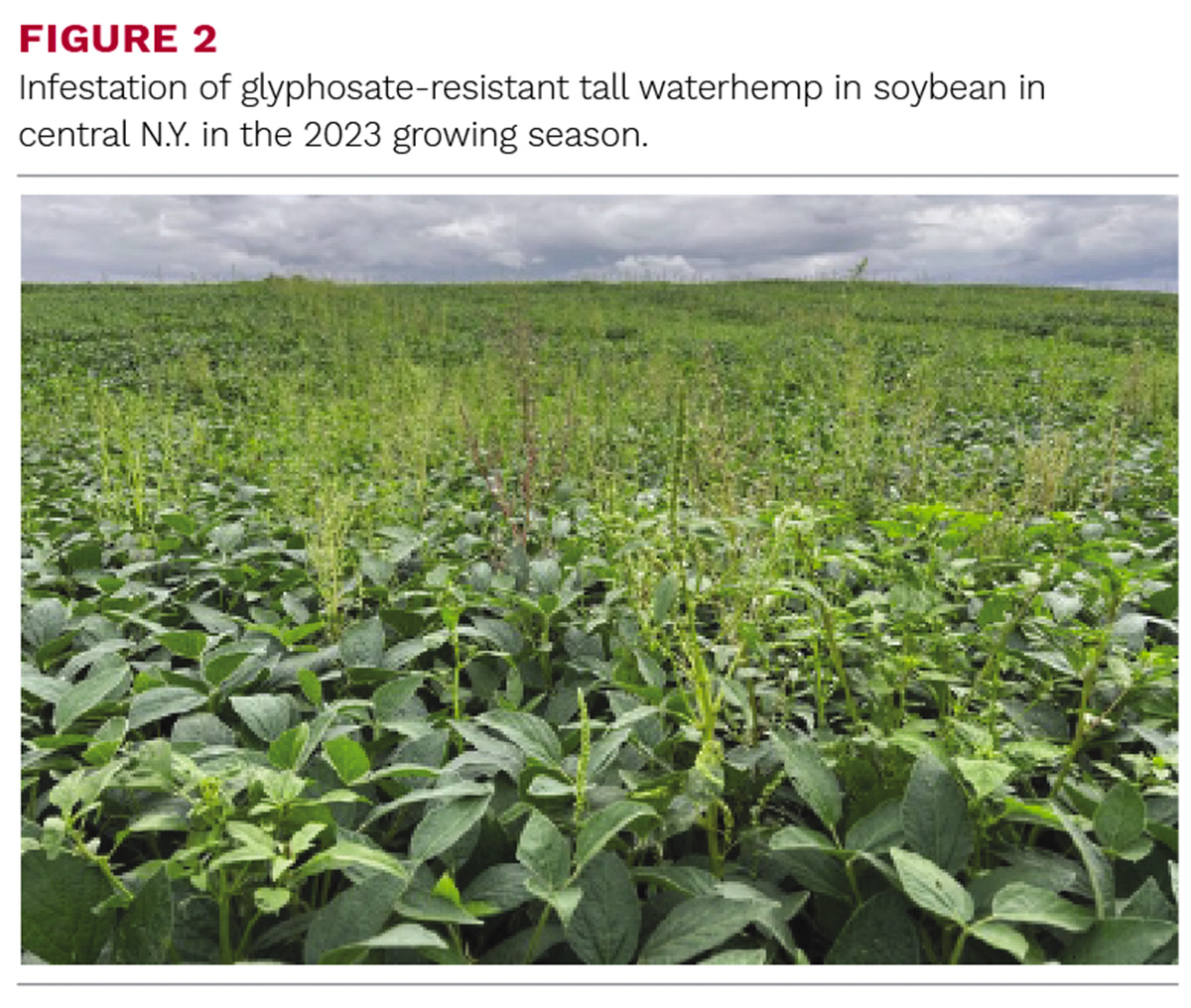Two new pigweed species including Palmer amaranth (Amaranthus palmeri S. Watson) and tall waterhemp (Amaranthus tuberculatus (Moq.) Sauer), which are commonly found in midwestern and southern United States, have been identified recently in the Northeastern (NE) region. These two pigweed species are considered highly problematic in other U.S. regions and can cause significant grain yield losses in various field crops. Some of these newly invaded populations of Palmer amaranth and tall waterhemp in the NE region have also been found resistant to glyphosate. Rapid spread of these new pigweed species with evolved resistance to glyphosate can pose a serious management challenge for producers in the NE region.
This article highlights key biological characteristics of both Palmer amaranth and tall waterhemp, potential impacts of these pigweed species on field crops, status of herbicide resistance, and best management strategies.
BIOLOGICAL CHARACTERISTICS
Palmer amaranth and tall waterhemp are both summer annual broadleaf weeds in the pigweed family. One of the unique characteristics to identify Palmer amaranth from tall waterhemp is the longer leaf petiole than the leaf blade. Palmer amaranth leaves are generally diamond-shaped, hairless and some leaves also carry whitish V-shaped marks. In contrast, matured leaves of tall waterhemp are ovate to lanceolate and often appear shiny or waxy.
Stems of both Palmer amaranth and tall waterhemp are hairless. More information for the identification of Palmer amaranth and waterhemp plants is at Cornell Cals. Both Palmer amaranth and tall waterhemp are dioecious (separate male and female plants) and are prolific seed producers. Depending upon the growing conditions and crop competition, each female plant of Palmer amaranth and tall waterhemp can produce 100,000 to 1,000,000 seeds that can be viable for three to five years.

IMPACT ON FIELD CROPS
Both pigweeds emerge in multiple flushes throughout the growing season and compete with summer crops for moisture, nutrients, light, and space. For example, season-long competition of Palmer amaranth can reduce grain yields of corn and soybean up to 91 percent. Similarly, season-long competition from tall waterhemp at densities greater than 1,200 plants m-2 can reduce soybean grain yield by 98 percent. If uncontrolled, tall waterhemp competition can reduce corn yield up to 74 percent.
STATUS ON HERBICIDE RESISTANCE
Both pigweed species are prone to develop herbicide resistance. Several populations of Palmer amaranth and tall waterhemp have been reported with resistance to various herbicide site of action (SOA) across midwestern, southern, and central U.S. For instance, Palmer amaranth populations with resistance to ALS inhibitors (for example, imazethapyr and chlorimuron), triazines (for example, atrazine), synthetic auxins (for example, 2,4-D and dicamba), HPPD inhibitors (for example, mesotrione and tembotrione), dinitroanilines (for example, trifluralin), PPO inhibitors (for example, fomesafen and lactofen), VLCFA inhibitors (for example, s-metolachlor) and EPSPS inhibitors (for example, glyphosate) and GS inhibitors (for example, glufosinate). In addition, some Palmer amaranth populations with multiple resistance up to six herbicide SOA have been reported from Kansas and Arkansas.
Similarly, tall waterhemp populations with multiple resistance up to five herbicide SOA have been reported from Illinois and North Carolina. Glyphosate-resistant (GR) Palmer amaranth and tall waterhemp populations have recently been identified in NE states, including Connecticut and New York. In addition to glyphosate, Palmer amaranth populations from N.Y. have also shown resistance to ALS inhibitors, triazine and HPPD inhibitors, whereas the CT. Palmer amaranth population has shown multiple resistance to ALS inhibitors. Similarly, several tall waterhemp populations from N.Y. have recently been confirmed with resistance to glyphosate and ALS inhibitors. Increased EPSPS gene (target gene for glyphosate) copies have been found to cause glyphosate resistance in GR Palmer amaranth populations from N.Y. and CT.

BEST MANAGEMENT STRATEGIES FOR GR PIGWEEDS IN NE FIELD CROPS
Growers should adopt the following strategies to effectively manage glyphosate- and ALS-resistant Palmer amaranth and tall waterhemp populations in field crops and to prevent further spread of resistance in the region:
- Start clean, with effective burndown herbicides to control the first flush of Palmer amaranth and tall waterhemp, before planting a summer field crop.
- Adopt a competitive crop rotation, where possible.
- Use effective preemergence herbicides with multiple SOA at planting and overlapping residuals.
- Monitor pigweed emergence closely and make timely applications of alternative (other than glyphosate and ALS inhibitors) effective postemergence herbicides with multiple SOA (premixtures or tank-mixtures) at full label-use rates.
- Scout fields after herbicide applications and eliminate pigweed escapes with alternative herbicides or mechanical/cultural methods. Do not let escaped GR Palmer amaranth or tall waterhemp go to seed!
- Follow proper sanitation and control pigweed plants growing around field borders, ditches, and roadsides.
- Utilize effective burndown herbicide programs to control pigweed seedlings after harvesting field crops to prevent seed production and soil seedbank replenishment.
- Integrate a winter cover crop such as cereal rye in corn-soybean rotation. Let the cereal rye grow as long as possible to achieve maximum shoot biomass in the spring and terminate it within one to two weeks of corn or soybean planting.
- Sanitize and clean field equipment (tillage, combine, harvester) properly to reduce pigweed seed movement from field-to-field.
- Do not use animal feed/hay, manure or crop seed contaminated with pigweed seeds.
- Utilize diversified weed control tactics, including cultural practices (cover crop, improved agronomic practices, etc.), timely herbicide applications with multiple effective SOA, mechanical practices (tillage, harvest weed seeds control) to successfully control GR Palmer amaranth and tall waterhemp.
 |
This article appeared in PRO-DAIRY's The Manager in March 2024. To learn more about Cornell CALS PRO-DAIRY, visit PRO-DAIRY. |









